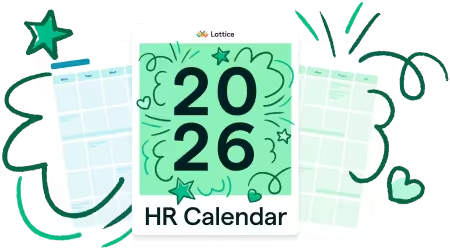Accessibility Policy Template


Download this template for free
By submitting your information, you agree to Lattice's Terms of Service and Privacy Policy. You can opt out anytime.
Thanks! We'll be in touch soon.
Creating an inclusive and accessible workplace isn’t just a legal obligation — it’s a commitment to ensuring every employee can participate fully and equitably in the workplace. An accessibility policy outlines your organization’s approach to removing barriers that might prevent individuals with disabilities or impairments from accessing your physical space, digital tools, or employment opportunities.
This policy will be particularly useful for organizations that want to formalize their efforts in compliance with the Americans with Disabilities Act (ADA), the Accessibility for Ontarians with Disabilities Act (AODA), and/or other global accessibility standards, while also demonstrating their commitment to diversity, equity, inclusion, and belonging.
What the Accessibility Policy Should Include
To be effective, your accessibility policy should cover:
- Statement of commitment to accessibility, inclusion, and equity
- Scope: Who the policy applies to (e.g., employees, candidates, customers, vendors)
- Legal framework (e.g., ADA, AODA, local/national laws)
- Workplace accommodations process: How individuals can request support and what to expect
- Digital accessibility: Ensuring software, websites, and tools meet accessibility standards
- Facility and physical accessibility: Guidelines for making buildings, offices, and equipment accessible
- Employee training and awareness programs
- Roles and responsibilities for HR, managers, and accessibility leads
- Feedback mechanisms for reporting accessibility concerns
- Ongoing improvement and policy review schedule
Purpose of This Policy
The purpose of this policy is to outline [Company Name]’s commitment to providing an inclusive and accessible environment for all employees, job applicants, clients, and visitors. This policy ensures we meet or exceed all relevant accessibility legislation and that we continuously improve our practices to remove barriers to access, opportunity, and participation.
Sample Accessibility Policy
{{rich-highlight-1}}
Effective Date: [Insert Date]
Last Reviewed: [Insert Date]
1. Policy Statement
At [Company Name], we are committed to fostering an inclusive environment where everyone — regardless of ability — can access, contribute to, and thrive in the workplace. We uphold accessibility as a core component of our commitment to diversity, equity, inclusion, and belonging (DEIB).
We aim to eliminate barriers and provide accommodations to ensure full participation for employees, applicants, clients, and visitors with disabilities or impairments.
2. Scope
This policy applies to:
- All employees (full-time, part-time, temporary, and contractors)
- Job applicants during the recruitment process
- Visitors to [Company Name] premises
- Clients or customers interacting with our services or platforms
- Vendors or third-party providers working with [Company Name]
3. Legal Compliance
[Company Name] complies with all applicable accessibility legislation, including:
- The Americans with Disabilities Act (ADA)
- Section 508 of the Rehabilitation Act (if applicable)
- Accessibility for Ontarians with Disabilities Act (AODA) [for Canadian employers]
- Any local/state/national accessibility laws where we operate
We also align our practices with international accessibility standards such as the Web Content Accessibility Guidelines (WCAG) 2.1 Level AA.
4. Workplace Accommodations
We provide reasonable accommodations to qualified individuals with disabilities to support their full participation in the hiring process, onboarding, employment, and career development.
How to request an accommodation:
- Employees or candidates may request an accommodation by contacting HR at [HR email/contact].
- Requests can be verbal or written and do not require disclosure of medical details to managers.
- HR will review requests in a timely, confidential manner and may request documentation if needed.
- Approved accommodations may include, but are not limited to:
- Modified workstations or equipment
- Flexible schedules or remote work options
- Sign language interpreters
- Assistive technology or software
- Modified duties or job responsibilities
5. Physical Accessibility
[Company Name] is committed to maintaining accessible physical workspaces. This includes:
- Barrier-free entrances and exits
- Accessible restrooms and common areas
- Clear signage with visual and tactile elements
- Accessible parking and transportation support (where applicable)
- Adjustable desks, chairs, and ergonomic equipment available upon request
If any facilities are temporarily inaccessible (e.g., due to maintenance or construction), alternate arrangements will be communicated and provided.
6. Digital Accessibility
All internal and external digital content, tools, and platforms will be developed and maintained to be accessible to individuals with visual, auditory, cognitive, or physical disabilities.
This includes:
- Company websites and customer-facing platforms
- Internal HR systems, intranet, and communications tools
- Learning and development content
- Software used for productivity and collaboration
[Company Name] will conduct periodic audits to ensure compliance with WCAG standards and provide training to content creators and developers on accessibility best practices.
{{rich-highlight-3}}
7. Training and Awareness
We provide training to ensure all employees understand their responsibilities related to accessibility:
- New hire onboarding includes accessibility and inclusion training
- Managers receive additional guidance on handling accommodation requests
- Teams involved in hiring, development, product, or facilities receive specialized accessibility training
- Annual refresher training will be provided to reinforce awareness
8. Roles and Responsibilities
- HR: Oversees accommodation requests, ensures compliance, and provides support
- Managers: Support employees in using accommodations and fostering inclusive team dynamics
- IT and Product Teams: Ensure digital systems and tools are accessible
- Facilities: Maintain physical accessibility and address reported concerns
- All Employees: Contribute to an inclusive workplace and report any accessibility issues they observe
9. Feedback and Reporting
Feedback on how [Company Name] is meeting accessibility goals is always welcome.
You can provide feedback or report barriers by:
- Emailing [accessibility@company.com]
- Using our anonymous feedback form [link]
- Contacting HR or your manager directly
We review all feedback and strive to respond or take action within 10 business days.
10. Continuous Improvement
Accessibility is an ongoing effort. [Company Name] commits to:
- Regularly reviewing this policy (at least annually)
- Updating practices in line with new legislation and technologies
- Consulting with employees, accessibility experts, and advocacy groups for feedback
Frequently Asked Questions
What qualifies as a disability under this policy?
A disability may include physical, mental, sensory, or cognitive conditions that limit one or more major life activities. This includes both visible and invisible disabilities, as defined by applicable laws.
Do I need to disclose my disability to receive an accommodation?
You do not need to disclose the specific nature of your disability to your manager. You may work directly with HR, who will keep all medical or disability information confidential.
What if I see an accessibility issue in the workplace?
You’re encouraged to report it through the channels listed in the Feedback and Reporting section. Your input helps us improve.
Are accessibility requests ever denied?
We aim to approve all reasonable accommodation requests. In rare cases where an accommodation causes undue hardship or is not feasible, we’ll work collaboratively to find an alternative solution.
Is accessibility only for employees with disabilities?
No — while accessibility is critical for individuals with disabilities, inclusive design often benefits everyone. For example, captions on videos help non-native speakers, and ergonomic tools support all employees.
{{rich-highlight-2}}
🚩 Please note: This sample policy is for informational purposes only and does not constitute legal advice. It is a generic template that may not suit your specific circumstances. When adopting or revising a policy, consult legal counsel to ensure compliance with all applicable laws and regulations.
✨ Disclaimer: This resource was developed with the help of artificial intelligence, though reviewed, edited, and approved by (real) humans.
Frequently Asked Questions

Your people are your business
Ensure both are successful with Lattice.





.webp)